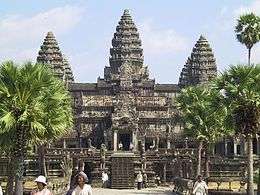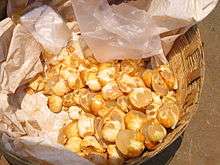Borassus
| Borassus | |
|---|---|
| | |
| Borassus flabellifer in Karainagar, Sri Lanka | |
| Scientific classification | |
| Kingdom: | Plantae |
| (unranked): | Angiosperms |
| (unranked): | Monocots |
| (unranked): | Commelinids |
| Order: | Arecales |
| Family: | Arecaceae |
| Subfamily: | Coryphoideae |
| Tribe: | Borasseae |
| Subtribe: | Lataniinae |
| Genus: | Borassus L.[1] |
| Species | |
|
See text. | |
| Synonyms[2] | |
| |
Borassus (Palmyra palm) is a genus of five species of fan palms, native to tropical regions of Africa, Asia and New Guinea. These massive palms can grow up to 30 m (98 ft) high and have robust trunks with distinct leaf scars; in some species the trunk develops a distinct swelling just below the crown, though for unknown reasons. The leaves are fan-shaped, 2–3 m long and with spines along the petiole margins (no spines in B. heineanus). The leaf sheath has a distinct cleft at its base, through which the inflorescences appear; old leaf sheaths are retained on the trunk, but fall away with time. All Borassus palms are dioecious, with male and female flowers on separate plants; male flowers are less than 1 cm long and in semi-circular clusters, sandwiched between leathery bracts in pendulous catkins; female flowers are 3–5 cm wide, globe-shaped and solitary, sitting directly on the surface of the inflorescence axis. The fruits are 15–25 cm wide, roughly spherical and each contain 1-3 large seeds. Depending on species, fruit color varies from black to brown, yellow or orange; the fibrous pulp is aromatic and sweet to taste. Each seed is enclosed in a woody endocarp, which protects it when the fruit is consumed by elephants, monkeys and other frugivores. At germination, the young seedling extends downwards into the soil and only a few leaves are visible above ground; this provides some protection against frequent fires in its savanna habitat; after an indeterminate number of years (the establishment phase), the seedling forms a stem and quickly grows above the savanna vegetation, where it is then less vulnerable to fire.[3]
Species
- Borassus aethiopum - African Palmyra palm, Rônier (and other names) (tropical Africa & Madagascar)
- Borassus akeassii - Ake Assi's Palmyra palm (West and Central Africa)
- Borassus flabellifer - Asian Palmyra palm/Lontar palm/Doub palm (southern Asia from India to Indonesia)
- Borassus heineanus - New Guinea Palmyra palm (New Guinea)
- Borassus madagascariensis - Madagascar Palmyra palm (Madagascar)
Cultivation and uses


Palmyra palms are economically useful and widely cultivated, especially in southeast Asia. The palmyra palm has long been one of the most important trees of Cambodia and India, where it has over 800 uses. The leaves are used for thatching, mats, baskets, fans, hats, umbrellas, and as writing material.
In Cambodia, the tree is a national floral symbol/emblem that is seen growing around Angkor Wat. Palmyra palm can live for over 100 years.
In ancient India and Indonesia, Palmyra leaves were used as writing paper, with their parallel veins providing a useful rule. In India, mature leaves of suitable size, shape and texture were chosen and preserved by boiling in salt water with turmeric powder. Once dry enough, the leaf surfaces were polished with pumice, cut to the proper size and a hole was cut in one corner. Each leaf has four pages and a stylus is used to write; the style is cursive and interconnected. Completed leaves are then tied up as sheaves.
The black timber is hard, heavy, and durable and highly valued for construction, especially in structures exposed to water, such as wharves, fences and boats.

The tree also yields many types of food. The young plants are cooked as a vegetable or roasted and pounded to make meal. The fruits are eaten roasted or raw, as are the young, jelly-like seeds. A sugary sap, called toddy, can be obtained from the young inflorescence, both male and female, and this is fermented to make a beverage called arrack, or concentrated to produce a crude sugar called jaggery/palm sugar. It is called Gula Jawa (Javanese sugar) in Indonesia and is widely used in Javanese cuisine. The roots can be dried to form Odiyal, a hard chewable snack. In addition, the tree sap is taken as a laxative, and medicinal values have been ascribed to other parts of the plant.
In Tamil culture
The Palmyra tree is the official tree of Tamil Nadu. In Tamil culture it is called karpaha,"nungu" "celestial tree", and is highly respected because all its parts can be used. The recently germinated seeds form fleshy sprouts below the surface which can be boiled and eaten as a fibrous, nutritious food. The germinated seed's hard shell is also cut open to take out the crunchy kernel which tastes like a water chestnut but sweeter. The ripe fibrous outer layer of the fruits is edible after boiling or roasting. When the fruit is tender, the kernel inside the hard shell is an edible jelly that is refreshing and rich in minerals. When the crown of the tree from which the leaves sprout is cut one can maket a cake. In ancient times, dried palm leaves were used to write manuscripts.
Palakkad, Kerala
Palakkad District of Kerala State is popularly known as land of Palmyra trees (കരിമ്പനകളുടെ നാട് ). Palmyra trees are known as the icon of this district and has a vast cultural, heritage and literary association. Many novels, stories and poems revolve around these trees The path-breaking Malayalam novel written by the Indian writer O. V. Vijayan, Khasakkinte Itihasam mentions Palmyra trees in various angles. Many people especially in eastern Palakkad live on earnings by tapping Palmyra toddy, which is sold in outlets controlled by co-op societies. The district authorities are taking action to preserve these trees and maintain Palakkad’s identity.
References
- ↑ Linnaeus, Species Plantarum 1187. 1753. Type:B. flabellifer
- ↑ "Kew World Checklist of Selected Plant Families". Retrieved 18 January 2016.
- ↑ Bayton, Ross P. (2007). "A revision of Borassus L. (Arecaceae)". Kew Bulletin. 62: 561–586.
External links
| Wikimedia Commons has media related to Borassus. |
- http://www.plantnames.unimelb.edu.au/Sorting/Borassus.html -excellent Australian site of multilingual fruit names
- http://www.pacsoa.org.au/palms/Borassus/index.html
- http://www.borassus-project.net